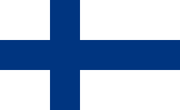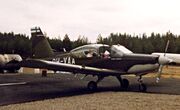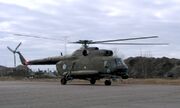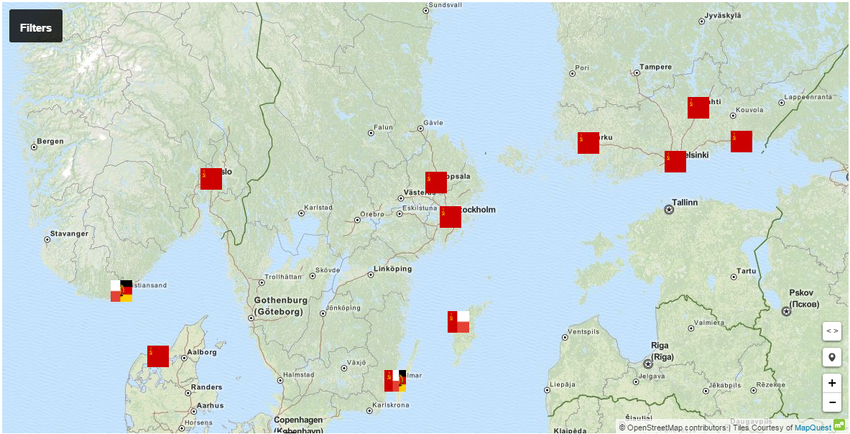
The Finnish flag.
The location[]
Finland is a Northern European nation bordering Sweden and Russia. Its capital, Helsinki, sits on a peninsula and coastal islands in the Baltic Sea, and is home to the 18th-century fortress Suomenlinna, the Seurasaari open-air museum and a neoclassical cathedral. The Northern Lights can be seen from its Arctic Lapland province, also home to the country’s main ski resorts. Kittilä (Inari Sami: Kittâl, Northern Sami: Gihttel) is a municipality of Finland within the area of the former Lappi province. The place is hilly and near-permanently covered in snow and ice.
Finland is known as "The country of thousands lakes and islands" Thier about ~188,000 lakes (larger than 500 m2 or 0.12 acres) and 179,000 islands. Its largest lake, Saimaa, is the fourth largest in Europe. The highest point in Finland is a spur of Ráisduattarháldi at 1,324 m (4,344 ft) known as Hálditšohkka at the border of Norway.
In the Köppen climate classification, the whole of Finland lies in the boreal zone, characterized by warm summers and freezing winters. Within the country, the temperateness varies considerably between the southern coastal regions and the extreme north, showing characteristics of both a maritime and a continental climate. Finland is near enough to the Atlantic Ocean to be continuously warmed by the Gulf Stream, so it is warmer than Siberia, Alaska and Greenland.
The once glacier covered landscape is now 86% covered in coniferous taiga forests and fens, with little cultivated land. The forests consists of pine, spruce, birch, and other species. The rest of the land is peat bog, rough farmland, built on or bare granite rock.
In 1950, 46% of Finnish workers worked in agriculture and a third lived in urban areas. Industry was starting up in the towns, but many emigrated to Sweden between 1955 and 1975 to find jobs.
Finland is the largest producer of wood in Europe and among the largest in the world and a leader in chipboard, paper and cardboard production. They now make other things like electrical components, mobile phones, gravel, steel and chemicals.
The Soviet plan[]
The plan[]

Finnish Minelayer Hameenmaa in 1982.

A Finnish Valmet L-70 Vinka.

A Finnish Mi-8 helicopter. They are made and used by Russia. The Soviets and Fins used them in the Cold War.
Whist this was unlikely it was still a possibility if Finland fell out with the USSR. Finland was terrified of a repeat of the Winter War of 1939-1940. It was a military conflict between the Soviet Union and Finland in 1939–1940. It began with the Soviet invasion of Finland on 30 November 1939, and ended with the Moscow Peace Treaty on 13 March 1940. Finland joined forces Nazi Germany in 1941 as a bid to regain lost territory like Petsamo, only to find it's self on the losing side. The Soviet Union had leased the port of Porkkala for it's navy to use between 1940 and 1955.
Finland survived the cold war as a pseudo-neutral nation that was covertly in the pay of the USSR. They were allowed to be freer that the official Soviet satellite states like Poland and could help their fellow Scandinavian nations in non-NATO/Warsaw Pact related affairs. Finnish pseudo-neutrality enraged America.
Some Soviet Backfire bombers armed with a nuclear capable cruise missiles flew over the region in later years of the Cold War and were intercepted and escorted out of NATO airspace by NATO's Baltic Air Policing Unit.
By what I can ascertain, if war had come there would have been a navel assault on the south and a block bombing campaign in the region ahead of a land assault across the entire Finnish border. Heavy bombing would also hit Oulu prior to its invasion by both sea and across land from Karelia in the USSR. Some northern locations like Kittilä municipality would be taken by airborne troops to help encircle the Norwegian province of Finnmark. Kittilä (Inari Sami: Kittâl, Northern Sami: Gihttel) is a municipality of Finland within the area of the former Lappi province.
Kuusamo and Kajaani was on the target list as the USSR planned to cut the nation in half by driving at Oulu as in the 1939 Winter War. Kotka, Lahti, Helsinki would be taken by a few Soviet paratroopers and after the Red air force bombed it a bit.
After the USSR fell in 1991, Finland moved clearly into the Western geopolitical sphere by joining both the European Union and the Eurozone, but it has never made any attempts to get into NATO so far due to Russian fears over NATO expatiation.
Finnish–Estonian defense cooperation was a major policy in the 1930s and 1990s.
Battle maps[]

Soviet attacks in northern Scandinavia.

Soviet attacks in mid Scandinavia.

Invasion of southern Scandinavia.
.
The Swedish plan[]
By what I can gather it would have seen heavy bombing of Soviet units around Oulu and/or Turku prior to its invasion by the Sweden by both sea and air with the aim of setting up a safe zone for a pro-Western or strictly neutral Finnish rump state. Swedish backed resistance fighters, who were first organised in 1944, would operate in the south, south west and west of the country.
The British plan[]
By what I found the UK would send in the 5th (ski) battalion of the Scots Guards during the Cold War to help local rebels and resistance fighters. It was originally intended for them to fight against any Soviet forces attacking Finland after WW2, but stayed a possible plan as the Cold War froze over.
The NATO plan[]
- By what I can gather NATO had 3 plans-
- Firstly the use Swedish backed fighters and the Swedish plan if there was a surprise attack.
- Secondly the use of CIA thugs to topple the Finnish government and use right wing resistance fighters to take on the Soviets.
- Thirdly the Americans would use tactical nukes and chemical wepons on the advancing Soviet forces. If that failed, the mass uses of strategic nuclear weapons on the nation to wipe out anyone in Finand (Finns, Soviets, Swedes, British troops, CIA agents and any one else regardless of the tactical situatin afterwards, long term regional outcome or likely world anger after such an attack).
Also see[]
- Operation Square Leg (1980) and Exercise Hard Rock (1982)
- Germany's Fulda Gap
- Swedish pseudo-neutrality
- Seven days to the River Rhine (1979)
- French nuclear plans and the Force de Dissuasion
- The Swiss National Redoubt (1880-2010)
- North German Plain
- Finnish pseudo-neutrality
- Operation Northern Norway
- The southern Danube route
- The week of war policy
- Operation Gladio
- Berlin Wall and Checkpoint Charlie
- Greece, Turkey and southern Italy
- Operation E.M.I.L.
- USSR
- North Atlantic Treaty Organization (NATO)
- NATO (World political shenanigans)
- Secretary-General of NATO
- NATO command structures and HQs
- Skynet IV\Skynet 4 (AKA: "NATO-4")
- NATO's Baltic Air Policing Unit
Links[]
- http://www.theatlantic.com/photo/2011/06/world-war-ii-the-invasion-of-poland-and-the-winter-war/100094/
- http://coldwarsites.net/country/finland/
- http://www.vox.com/2014/8/29/6083849/russia-finland-airspace-nato-membership
- https://books.google.co.uk/books?id=IZRrt6zMtVMC&pg=PA40&lpg=PA40&dq=Cold+war+soviet+invasion+of+finland&source=bl&ots=2fCraooDHH&sig=p5IHzLDLtqYgEt7zS2yYImCbbYo&hl=en&sa=X&ei=kOTWVOGgMaWr7AaGo4GQBQ&ved=0CF4Q6AEwDQ#v=onepage&q=Cold%20war%20soviet%20invasion%20of%20finland&f=false
- http://coldwarsites.net/country/sweden/
- http://en.wikipedia.org/wiki/Operation_Gladio
- http://www.telegraph.co.uk/news/uknews/defence/5610430/Cold-War-nuclear-attack-plans-released.html
- https://en.wikipedia.org/wiki/Halti